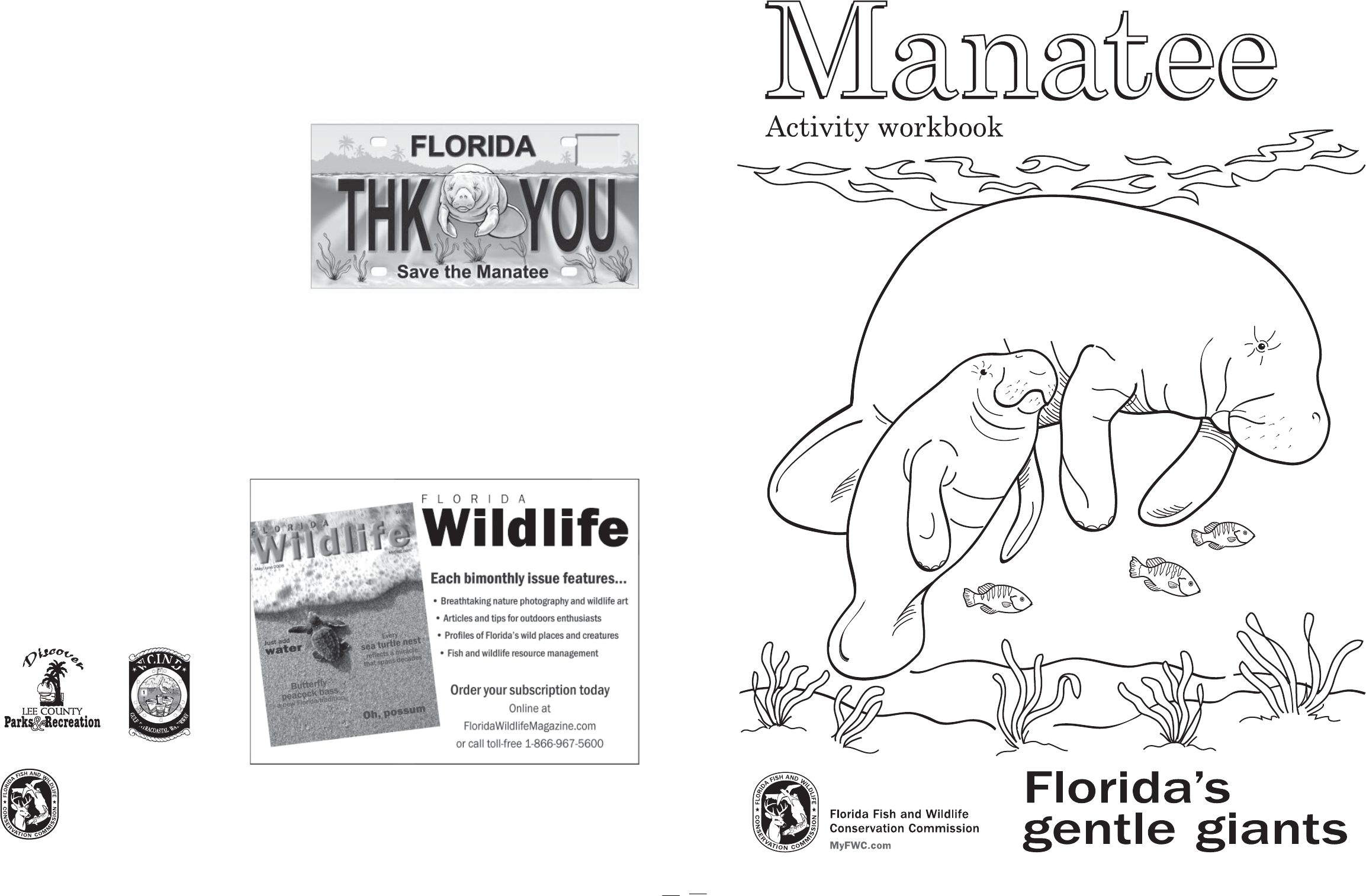
Check out our manatee decal collection!
Visit our Web pages to see the different decal designs available. Your donation to the Save the
Manatee Trust Fund helps with research, recovery, protection plans, habitat protection, sign
posting and educational materials for the benefit of Florida’s manatees. Browse our Florida
Fish and Wildlife Conservation Commission Web site for more information: MyFWC.com.
A note to educators
Manatees, Florida’s Gentle Giants coloring activity book was originally created by the Northeast
Florida Regional Planning Council with input from the Save the Manatee Club and the Florida
Department of Natural Resources. Several updates, additions and agency changes have occured
over the years. This issue has all new graphics, updated activities and more educational information
about manatees. Please let us know if you have other suggestions to improve this booklet. Page lay-
out and updated graphics are by Lizabeth West. Page four graphics are by Ann Marie Tavares. Page
16 graphic is by Llyn French.
Please credit the Florida Fish and Wildlife Conservation Commission if you use any of the text or
graphics from the booklet. Donations to the Save the Manatee Trust Fund are always welcome if you are
requesting bulk orders of our materials for your use.
Florida Fish and Wildlife
Conservation Commission
Imperiled Species Management Section
850-922-4330
MyFWC.com
revised 10/08
It matters to us
which plate you buy
Help preserve the future of Florida’s gentle
giants by purchasing a manatee license plate.
Proceeds directly benefit manatee research and
conservation. Available at tax collectors’
offices and online at buyaplate.com
Sunshine State Standards
for Science – Grades 3-7:
SC.3.N.1.1 SC.5.L.15.1
SC.3.L.15.1 SC.5.L.17.1
SC.4.N.1.1 SC.6.N.2.2
SC.4.L.16.3 SC.6.L.15.1
SC.4.L.17.1 SC.7.L.15.1
SC.4.L.17.3 SC.7.L.15.2
SC.4.L.17.4 SC.7.L.15.3
SC.5.L.14.2 SC.7.L.17.3.
G
U
L
F
I
N
T
R
A
C
O
A
S
T
A
L
W
A
T
E
R
W
A
Y
W
C
I
N
D
www.leeparks.org
“The printing and distribution of the Manatee Activity workbook is courtesy
of Lee County Parks & Recreation under a grant from WCIND.”
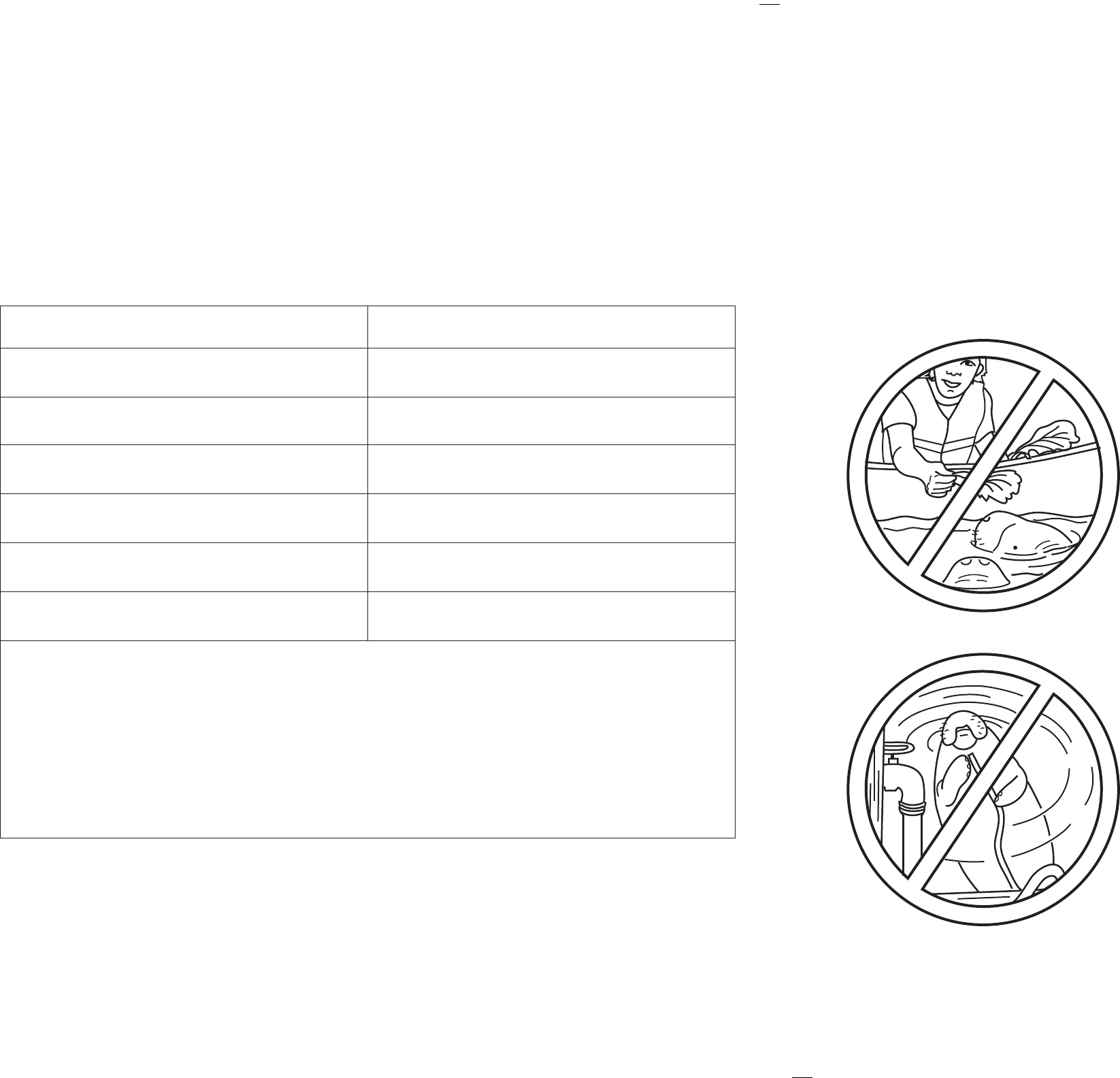
The Florida manatee before and after
work sheet
Before you start your lessons about manatees, take a few minutes to write down what you
know about these animals. Think about what you want to know about manatees and enter the
information below. At the end of your session, write down what you learned and see how your
lists compare.
Name: _____________________________________ Date: _______________________________________
What I know about manatees now What I learned about manatees
What do I want to know about manatees?
Based on what you learned about manatees, write a short story about the manatees that may live
in the waterways near you. Include area landmarks, waterways and marinas in your story. How can
manatees be better protected in these areas?
Remember, you can make a difference.
Note to teacher: Use the underlined words throughout this booklet as vocabulary words for your students.
Manatee protection
Manatees are classified as an endangered species and are protected under the federal
Endangered Species Act of 1973 and the Marine Mammal Protection Act of 1972. The Florida
Manatee Sanctuary Act of 1978 designates the entire state of Florida as a manatee sanctuary.
If you see an injured, orphaned or dead manatee or someone harassing a manatee, please call
the FWC Wildlife Alert number, 1-888-404-FWCC (3922). You may also dial #FWC or *FWC on
your cell phone (Note: out of state cell phones may not work with this service).
17
To avoid breaking the law and being
charged with manatee harassment, DO NOT
do the following activities:
■
Give food to manatees
■
Use water to attract manatees to your family’s
boat or dock where manatees may be
harmed
■
Separate a cow and her calf
■
Disturb manatee mating herds
■
Pursue manatees or chase them from warm
water sites
■
Disturb resting manatees
■
Hit, injure or harm manatees
■
Jump on, stand on, hold on to or ride
manatees
■
Grab or kick manatees
■
Block a manatee’s path if one or more moves
toward you
■
Hunt or kill manatees
■
Use your vessel to pursue or harass manatees
■
“Fish” for or attempt to hook or catch
manatees
Remember to watch wildlife without getting too
close.
Activity: What are three ways that you can help
protect manatees? (Use list above for ideas)
_____________________________________________
_____________________________________________
_____________________________________________
Class challenge:
1. Participate in a coastal or waterway clean up
event.
2. Recycle fishing line:
www.fishinglinerecycling.org.
3. Make posters to increase manatee awareness
at your school.
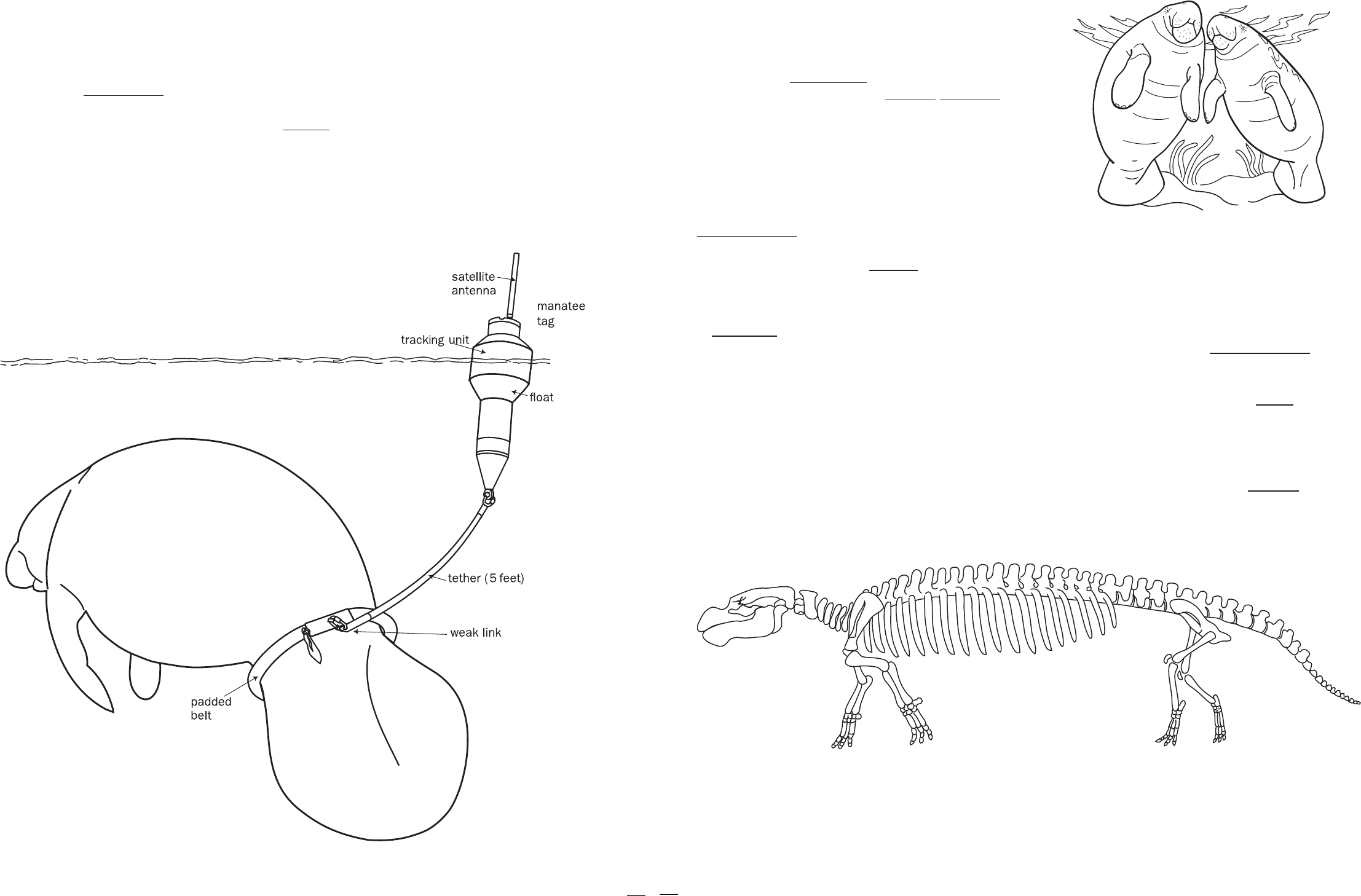
Prehistoric Sirenians
For millions of years, long before Christopher Columbus discovered the New World, both dugong
and manatee (Sirenians) species lived in the coastal waterways, rivers and springs of what we
now know as Florida. Other Sirenian species were found in various locations around the world.
The following information will help you research these unique mammals.
1
■
Ancestral forms of Sirenians date back
about 55 million years.
■
Forty-five million-year-old Sirenian fossils
have been found in Florida.
■
The elephant (Proboscidian) and a
hippopotamus-like prehistoric animal
(Desmostylian) most resemble Sirenians.
■
Manatee fossils have been found in Florida
that date back to 1 million years ago.
■
Elephants, hyraxes, aardvarks and
manatees share similar characteristics.
■
Research shows that the earliest known
human inhabitants of Florida (Paleo-Indians)
hunted the manatee for its meat, bones, hide
and fat.
■
Recent Sirenian fossil discoveries in
Jamaica show that manatees evolved from
four-footed, aquatic plant-eating land
animals.
Activity: Research the prehistoric Proboscidian and Desmostylian species to see what these
animals looked like and then compare them to Sirenians.
Pezosiren portelli
What is a manatee?
The Florida manatee (Trichechus manatus
latirostris), a sub-species of the West Indian
manatee, is an endangered aquatic mammal
found in Florida’s waterways. While manatees in
general are sometimes called sea cows,because
they consume aquatic plants, the female manatee
is better known as the cow. A newborn or young
manatee is called a calf, and a mature male
manatee is called a bull.
16
What should you do if you see a
tagged manatee?
If you see a manatee with a tag (floating cylinder unit with an antenna) attached to its tail,
please leave the tag and manatee alone. The manatee tag is a tracking unit that contains
a satellite and VHF transmitter. The unit allows researchers to monitor a manatee’s travel
patterns, habitat usage or reproductive success (females). Satellite information is recorded four
times per day on each tagged manatee. The VHF beacon helps researchers locate the manatee
for direct observations. When you see a tagged manatee, jot down your observation of the animal
along with the tag condition, color or markings, the manatee’s location, date and time of sighting
and call in a report to the Wildlife Alert number, 1-888-404-FWCC.
Activity: Color the manatee and the bands at the top of the tracking unit. (Each tagged
manatee has a different color band or pattern.)
Remember to not touch a tagged manatee or bother wild animals.
The tag unit is designed to break away if
the manatee is entangled. Researchers
are able to retrieve the tag unit via
information from the satellite.
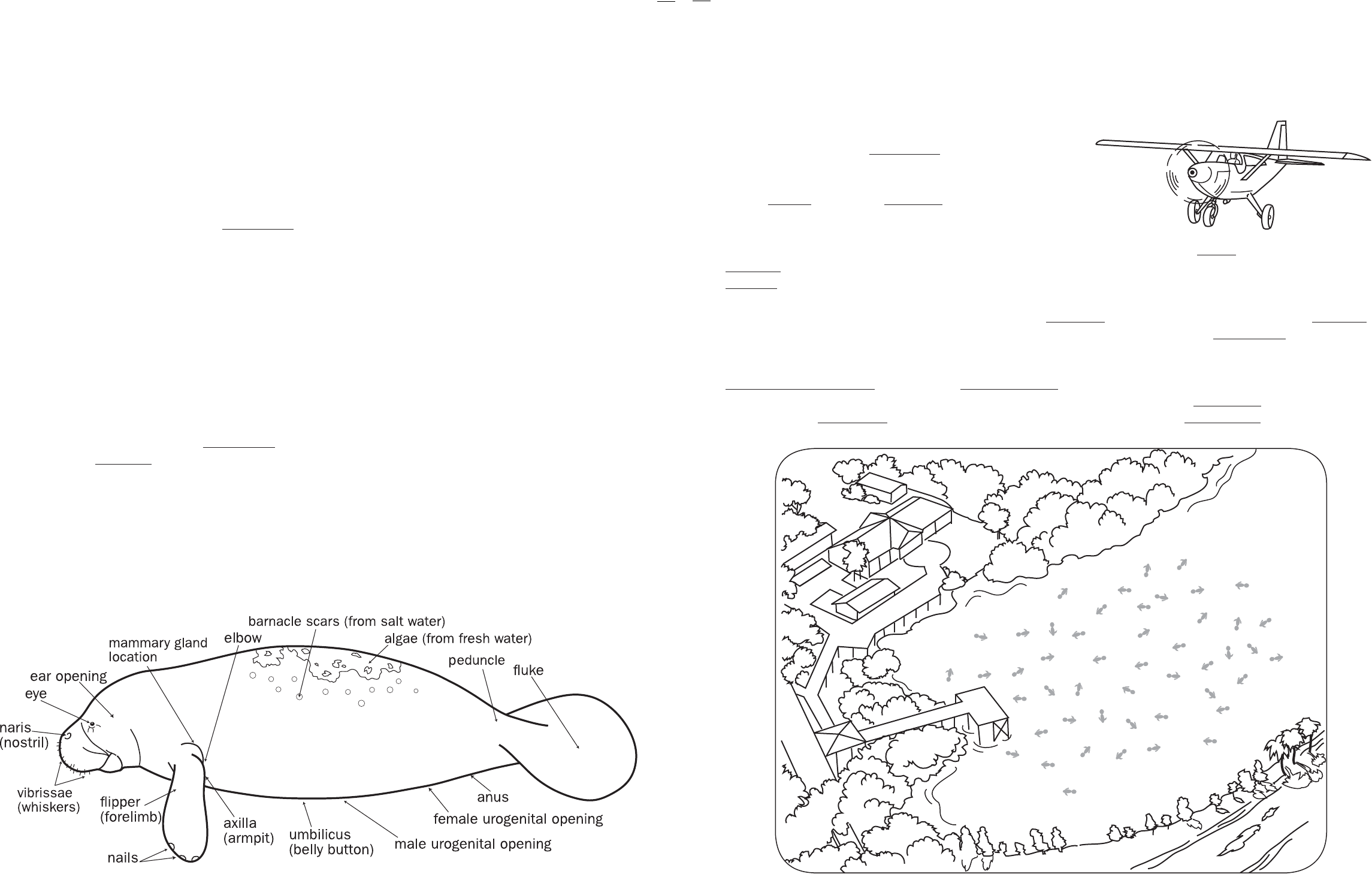
What do manatees look like?
Manatees are large, gray aquatic animals with thick, finely-wrinkled skin. From the blunt
whiskered snout, a manatee’s body is torpedo-shaped and then tapers to a flat, paddle-shaped
tail. Two forelimb flippers, with up to four “finger” nails, are located near the head. Like all
mammals, manatees have hair on their bodies. Although the hair is very sparse, it exists in short
strands from a manatee’s head all the way down to its tail. Manatees do not have external ear
lobes, eyelids or eyelashes. A thin membrane protects the manatees’ eyes when underwater. Stiff
bristles around its mouth help manatees hold food while eating.
Characteristics:
■
Small eyes
■
Finger nails on flippers
■
Fluke – paddle-shaped tail
■
Peduncle (narrow part of the tail)
■
Nostrils (open and close like valves)
■
Ears (small opening)
■
Vibrissae – stiff whiskers
Marching molars
Tooth replacement is an adaptation to the manatees’ diet of aquatic plants that are
mixed with abrasive sand. Over time, sand wears down the molars, which can make
chewing plants difficult. The adaptation allows for new teeth to erupt at the back of the
jaw and move forward until the worn-down teeth eventually fall out. Tooth replacement
(polyphyodont) occurs throughout the life of a manatee.
Activity: Color the manatee gray. Green or brown algae and white barnacles sometimes grow on
the backs of manatees. These natural colors help hide (camouflage) manatees in the water.
2
15
Population status and aerial survey
Activity: Look up the underlined words in the text below and write the definition on a
separate piece of paper.
The Florida manatee population is believed to be
at least 3,300. The exact number of manatees is
hard to determine because manatees live in areas with poor
water clarity, and their behavior of resting on the bottom of a
waterway can make them invisible to researchers during surveys.
Whenever winter conditions are good, researchers conduct a statewide aerial survey, called a
synoptic survey, to count manatees at warm water sites around the state. Researchers fly in
circular patterns in assigned sections of the state on a selected day. Each researcher records
the number of manatees seen in his or her section, and then submits the number of manatees
counted to the FWC Fish and Wildlife Research Institute. The survey results are highly variable
because of the wind and water conditions, the glare on the water and the probability of bottom
resting manatees.
Endangered species status and conservation goal: The Florida manatee is currently
listed as an endangered species in Florida. The conservation goal is to effectively manage the
population in perpetuity throughout Florida by securing habitat and minimizing threats.
Aerial view of a warm water site.
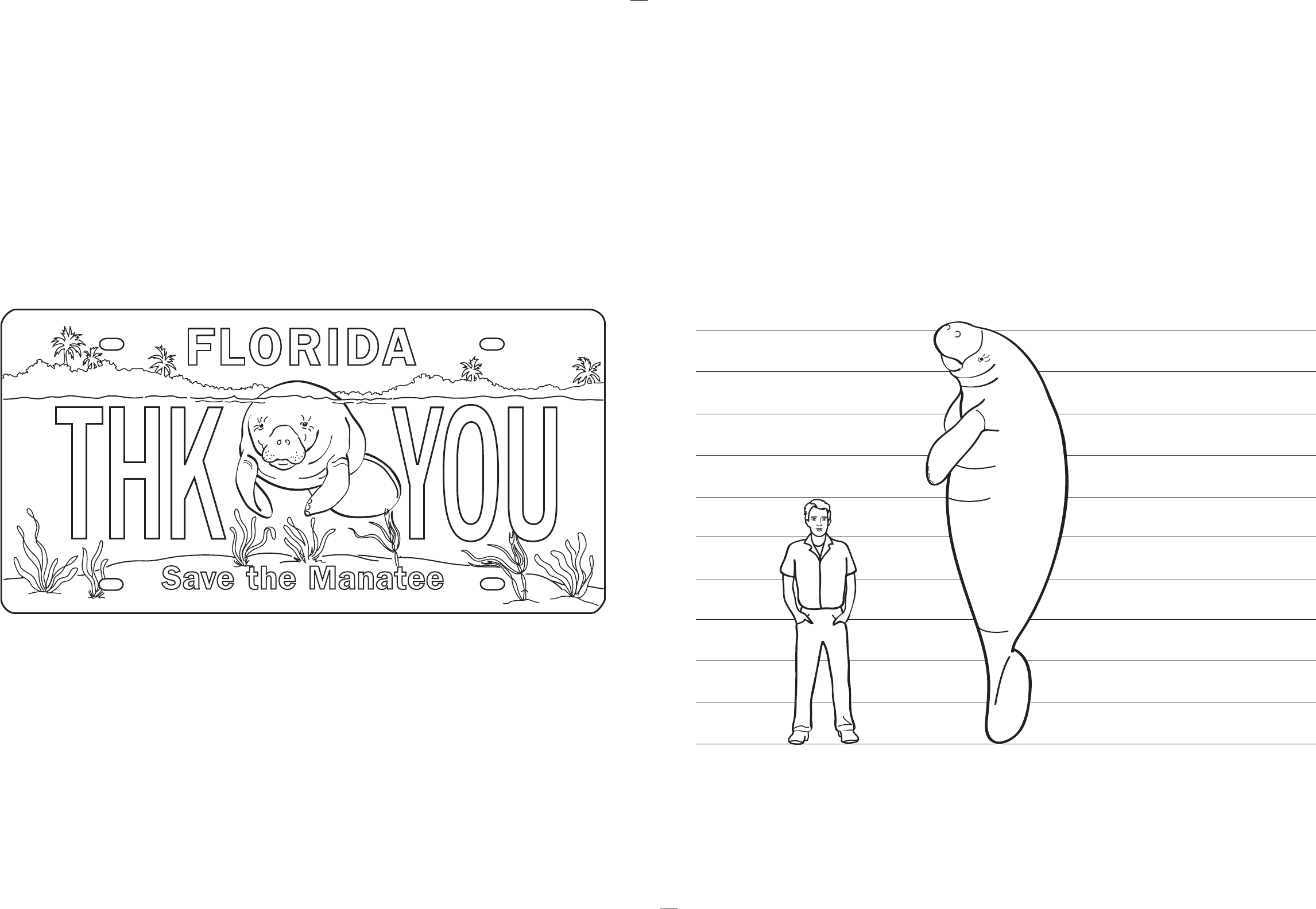
How big do manatees grow?
A calf weighs 60-80 pounds and is 4 to 4
1
/
2
feet in length at birth and grows quickly during
its first two years. During this time, the female sea cow nurses its young from teats found just
behind the base of the flippers. This occurs until the calf is weaned from nursing. Although the
average adult manatee is ten feet long and weighs about 1,200 pounds, manatees can grow much
larger. The heaviest manatee weighed was 3,600 pounds and measured 13 feet long. Female
manatees (cows) tend to be larger than male manatees (bulls).
Activity: Find an object (small car, golf cart, etc.) that weighs as much as a manatee weighs.
Class project: Use roll paper to make a 3-D actual size manatee to hang in your classroom.
10 feet
9 feet
8 feet
7 feet
6 feet
5 feet
4 feet
3 feet
2 feet
1 foot
0
3
Average size person:
6 feet tall
150 pounds
Average size manatee:
10 feet long
1,200 pounds
Draw another
animal: ______________
height:_______________
weight:_______________
14
Help manatees stay on the road
to recovery
Floridians support the Florida Fish and Wildlife Conservation Commission’s manatee
conservation, research and educational efforts by purchasing a special license plate for their
cars and trucks. The example below is a thank you to them.
Directions: Color the manatee gray and the letters black. The sea grass, which the manatees
eat, should be green. The skyline vegetation is also green. Color the water area around the
manatee blue.
By purchasing one of these speciality plates, people of Florida help manatees.
(If your family has a Save the Manatee license plate, “thank you for your support!”)
To nd out more information about the Save the Manatee license
plate, visit our Web site at: MyFWC.com. Plates may be purchased at
tax collectors’ ofces or at buyaplate.com.
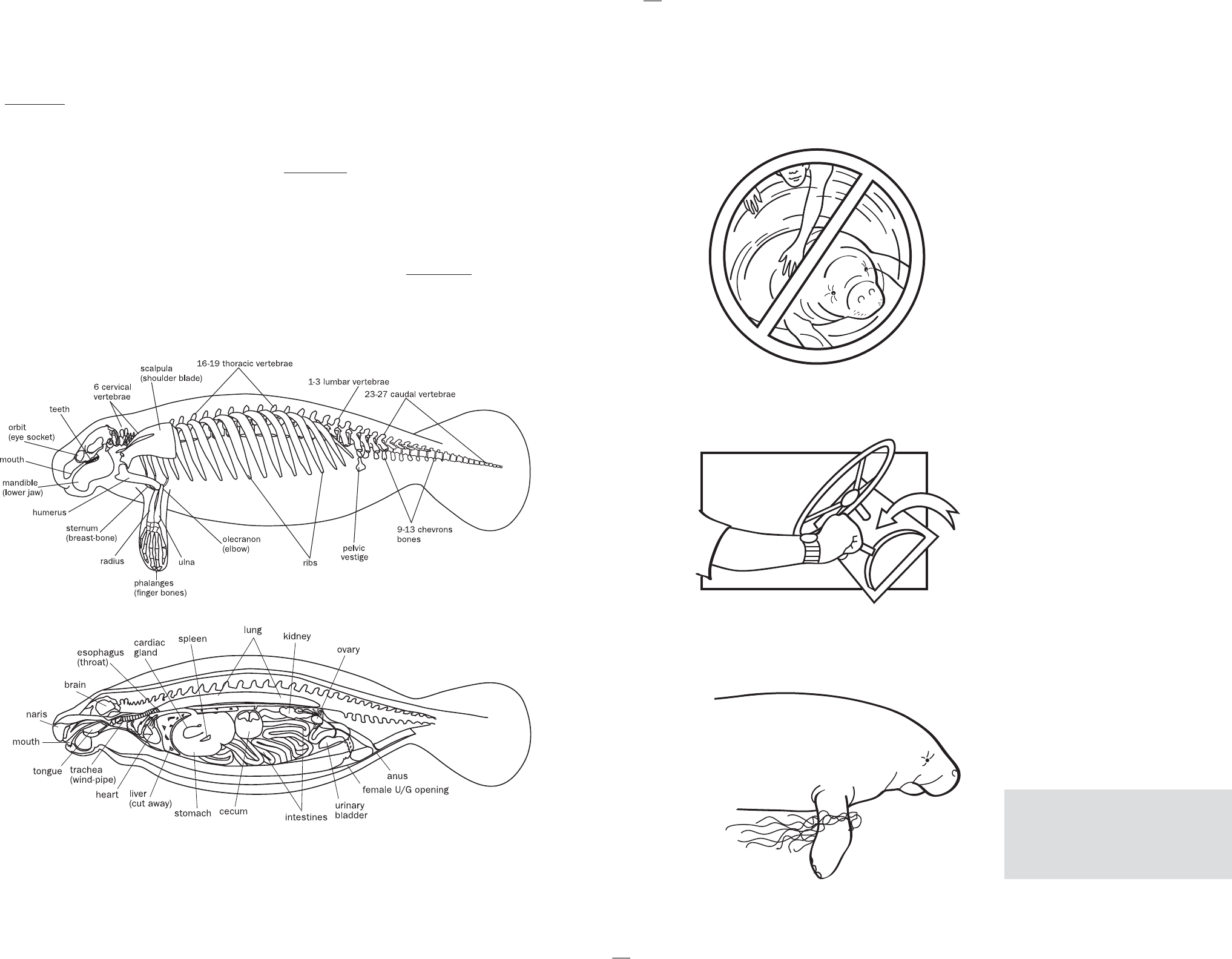
Manatee anatomy facts and trivia
Activity: Use colored pencils to color the internal organs of the manatee.
4
■
The digestive system of the manatee
is adapted to process large amounts of high-
fiber, low-protein food (aquatic plants).
■
Manatees can eat up to 10 percent of
their body weight in aquatic vegetation each
day.
■
The intestines of adult manatees can
measure up to 130 feet in length! It takes
seven days for food to pass through this long
digestive system.
■
Manatees produce a large amount of gas
from the food they eat.
■
The lungs of an adult manatee may
exceed three feet in length and extend along
the backbone under the protection of the ribs.
The length of the lungs helps manatees with
buoyancy control and allows the animal to
float horizontally and stay underwater for up
to 20 minutes at a time.
■
Manatee bones are massive and heavy
and lack marrow cavities in the ribs and long
bones of the flippers. Heavy bones allow the
manatee to easily submerge in order to graze
on aquatic plants.
13
1. Manatees are wild marine mammals found
mostly in Florida’s coastal areas. When you see
manatees in the wild, please __________________
_______________ as this could change the
manatee’s behavior. If you see a group of
manatees close to shore acting aggressively and
thrashing around, it is probably a mating herd.
Do not disturb the manatees or try to get their
attention.
2. Collisions with boats are the single highest
human-related contributor to manatee deaths
each year. One of the ways that boaters could
help manatees is by _____________________ the
speed of their boats when manatees are present.
When boaters follow the speed limits posted on
waterway signs, they are helping to protect
Florida’s manatees.
3. Litter, fishing line and storm debris are found in
Florida’s coastal waters. Do your part by
_______________________________________________
and by helping with beach clean-ups or
recycling efforts in your area.
Answers:
1. Do not pursue, disturb or harass
manatees
2. Reducing or slowing
3. Keeping litter, fishing line, garbage,
etc. out of the waterways.
Manatee conservation
Fill in the blank space in the sentences below. Think about what the picture is suggesting you do
for manatee conservation.
(Color the circle/slash red)

5
Where can you find manatees in
Florida?
Manatees are found throughout Florida water-ways
including rivers, estuaries, saltwater bays, canals
and coastal areas, particularly where sea grass
beds and other aquatic plants grow. During the
summer months, manatees may travel as far north
as Virginia or Rhode Island and as far west as
Texas. When winter approaches, manatees return
to the warmer waters around Florida, aggregating
in natural warm-water springs or at power plant
discharge canals (+).
Several facilities are used to rehabilitate injured
or sick wild manatees. Rehabilitated manatees may
be put on display prior to release at the following
locations:
■
Lowry Park Zoo + (Tampa)
■
Miami Seaquarium + (Miami)
■
SeaWorld of Florida + (Orlando)
Other Florida attractions or parks provide
manatee education programs and minimal
rehabilitation service*
■
Blue Spring State Park + (Orange City)
■
Crystal River National Wildlife Refuge (Crystal
River)
■
Disney’s Epcot Center – Living Seas exhibit* +
(Orlando)
■
Edward Ball Wakulla Springs State Park +
(Wakulla Springs)
■
Homosassa Springs State Wildlife Park*
Blue Waters + (Homosassa Springs)
■
Merritt Island National Wildlife Refuge +
(Merritt Island)
■
Manatee Springs State Park (Chiefland)
■
Moore’s Creek – Fort Pierce Utilities Authority +
(Fort Pierce)
■
Mote Marine Laboratory and Aquarium
(Sarasota)
■
Lee County Manatee Park at the Orange River
and Florida Power & Light discharge canal +
(Fort Myers)
■
South Florida Museum/Parker Manatee
Aquarium* (Bradenton)
■
Tampa Electric Company’s Manatee Viewing
Center + (Apollo Beach)
Activity: On the map, circle the places where you have seen wild manatees. Put a check mark
(
a) on the places where you have seen rehabilitated manatees or manatees on display.
12
What do waterway signs mean?
Color the sign border and shapes, below, ORANGE. The sign background is WHITE.
A, B, A, C, B, C
A. A circle shape means
– follow the posted rule on
the sign.
B. A diamond shape means
– DANGER! Look out for
something in the water.
C. A diamond shape with
a cross inside means – DO
NOT ENTER! (all vessels)
Activity:
Match the following messages to the correct
sign. Write A, B or C next to the sign
messages. Check your answers to see if you
are right.
____ Idle Speed – No Wake
____ Rocks
____ Slow Speed – Minimum Wake
____ Manatee Refuge
____ Stump(s)
____ Swim Area
Answers:
To report damaged waterway signs,
dial 1-866-405-BUOY (2869). Give the
following information:
■
Location of sign
■
Damage to sign
■
Name
■
Contact information
Remember to sign up for boating safety
classes at MyFWC.com.
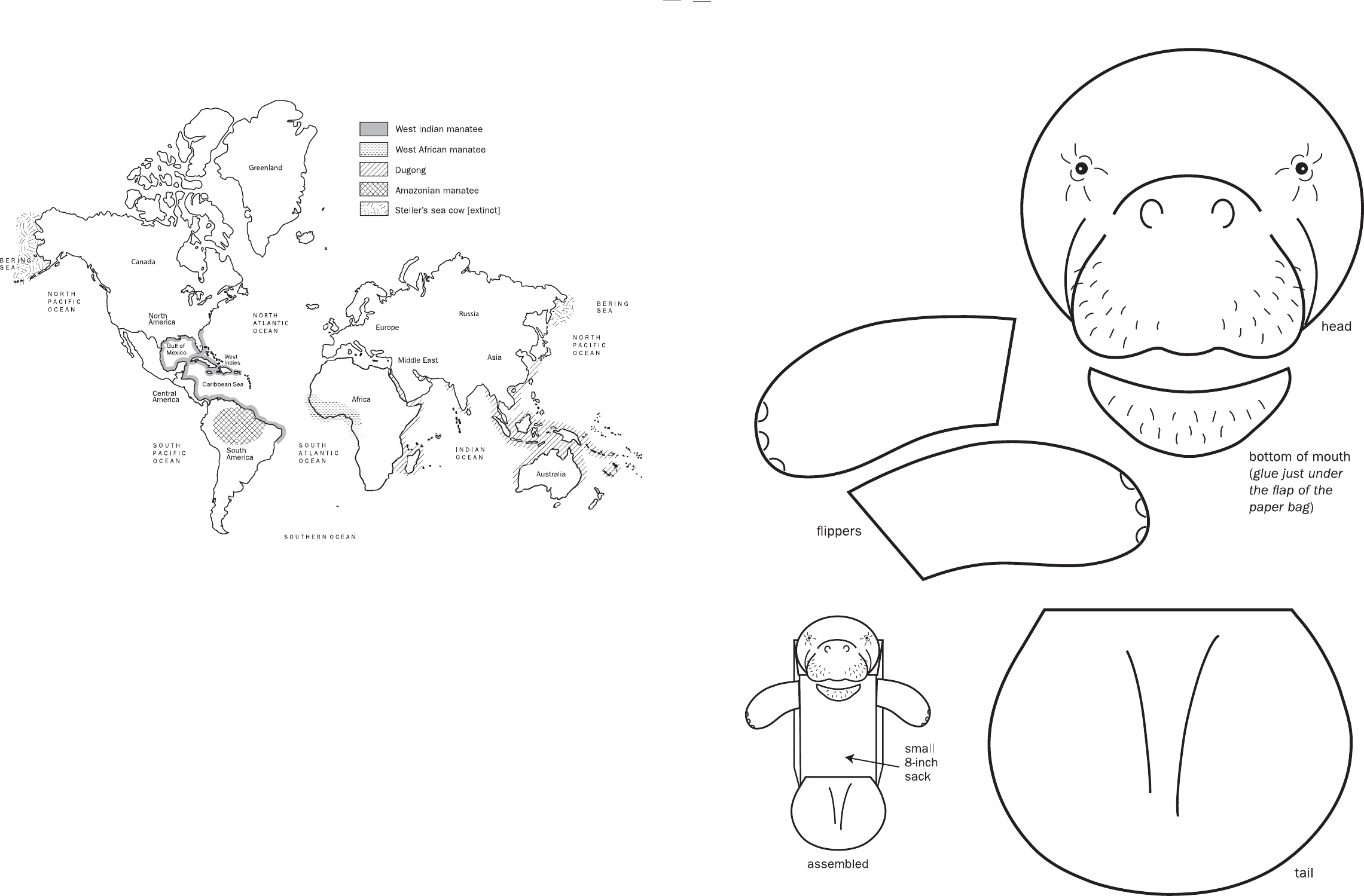
6
Sirenians of the world
Present day Sirenians are found around the
world and include three species of manatees
and one species of dugong.
West Indian manatee (Trichechus
manatus) – West Indian manatees are found
from the southern United States to the
northeast coast of Brazil and around islands
near these shores. The Florida manatee
(Trichechus manatus latirostris) is a sub-
species of the West Indian manatee and is
found in and around Florida’s waterways.
The Antillean manatee (Trichechus manatus
manatus) is another sub-species that is found
throughout the Caribbean and northeastern
South America.
Amazonian manatee (Trichechus
inunguis) – This species is restricted to the
fresh waters of the Amazon Basin.
West African manatee (Trichechus
senegalensis) – This species is found in the
coastal waters and rivers of western Africa.
Dugong (Dugong dugon) – the dugong
population is restricted to certain regions
of the coastal waters of 43 countries within
the Indian and Pacific oceans. The largest
surviving populations are found in northern
Australian waters.
Extinct species: Steller’s sea cow
(Hydrodamalis gigas) – This species was once
found in the Bering Sea and was hunted to
extinction within 27 years of discovery (1741-
1768).
Activity: Research one of these species and
draw or copy a picture of the animal.
11
Manatee puppet
Color each of the pieces gray, blue, brown
or a combination of these colors. Cut the
pieces out and glue them to a paper lunch
bag as shown below. Make sure that you
attach the head to the bottom of the bag
so that you can open the manatee’s mouth.
Give your manatee a name and herd
together with your other manatee friends.
Classroom idea:
Use the information in this
book to write a play about manatees. You can make
a different lunch bag character for each character
in your play.
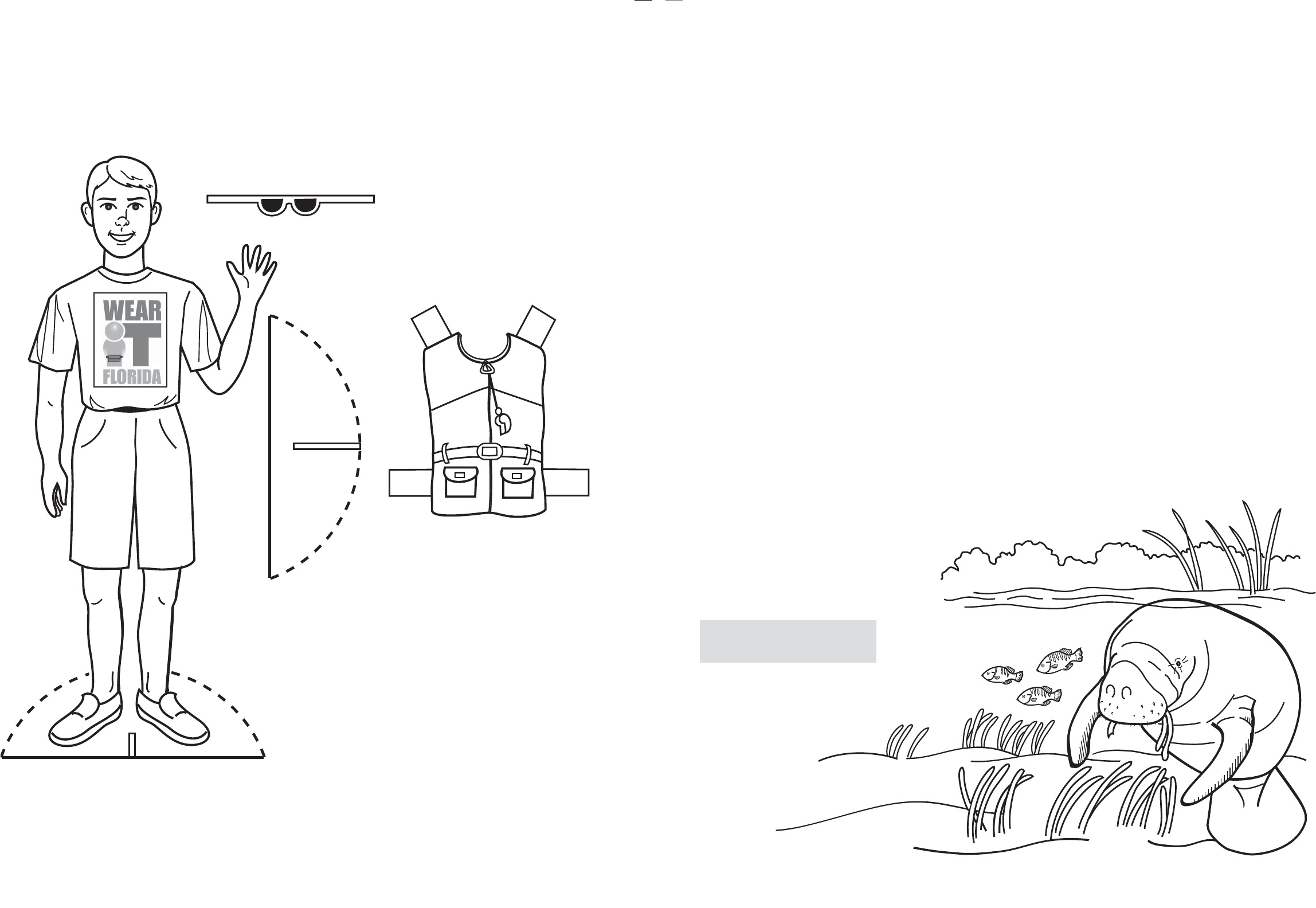
7
What are the four elements of habitat
that manatees need to survive?
Activity: Fill in the blanks to find out the basic elements of habitat.
1. Manatees eat plants that grow in the water. These plants are called aquatic vegetation.
Aquatic vegetation is the best type of f__o__ for manatees to eat.
2. Manatees seek out and drink fresh w__t__ __ found in their environment. Manatees do not
need to rely on people to provide this for them.
3. Manatees are migratory animals. Their travel is influenced by seasonal changes. Travel
corridors are necessary for manatees to move back and forth between summer and winter
habitats. People who use these same waterway corridors must respect the manatees’ need for
safe passage and provide adequate sp__c__ for manatees to travel.
4. Manatees seek safe, protected areas, or sh__l__ __r where they can feed, rest, play, mate,
give birth or raise their young. In Florida, with the growing number of people and boats, safe
protected areas are more difficult for manatees to find.
Loss of habitat is one of the most serious threats to the manatee. Human activities are a
significant cause for manatee habitat loss through pollution, dredge and fill activity, water use
and development.
If any of the four elements of habitat – (1)___________, (2)___________, (3)___________ and
(4)_____________ – are missing, manatees cannot survive. It is up to all of us to help Florida’s
manatees survive.
Manatees use high tides to reach
feeding areas and shoreline
vegetation that are not easy to
get to when the tide is low.
Answers:
food, water, space and shelter.
10
Life jackets help save lives
Always be prepared when you plan a trip on a waterway. Practice preparing for your trip by
dressing the boating safety buddy. Lightly GLUE the page to another piece of paper. CUT out
the life jacket, sunglasses and other items and the boating buddy and place the items on your
buddy by folding the tabs. Help your buddy be better prepared for a trip on the water.
Wear polarized sunglasses so
you can see and avoid objects just below
the surface of the water (such as sea
grass beds, manatees and sea turtles).
Polarized lenses help cut the glare from
the sun on the water and also protect
your eyes.
Wear your life jacket when near shore
or on a boat.
Attach a whistle to your life vest
that has a plastic ball inside since cork balls
do not work well when wet. The whistle is
used to attract a rescuer’s attention and
help direct them to your location.
Put a small mirror in a pocket to use
to flash sunlight signals in an emergency.
Practice water safety rescues with
your parents before an emergency happens.
A life jacket is also called a Personal
Flotation Device or a PFD.
Make sure your
life jacket is Coast Guard approved and fits
well. Most important…remember to
WEAR YOUR LIFE JACKET!
Wear the proper life jacket for your activity
Type 1
– Off-shore life jacket – designed for rough weather – these will keep you afloat for a long time.
Type 2 – Near-shore life jacket – designed for near-shore, calmer waters where rescue time may be shorter.
Type 3 – Sport life jacket – commonly used for watersport activities – not designed for use in rough waters.
Type 4 – Throwable flotation – seat cushion, life ring – this device is not worn and is designed to be thrown to a
person who needs help
wearitorida.com
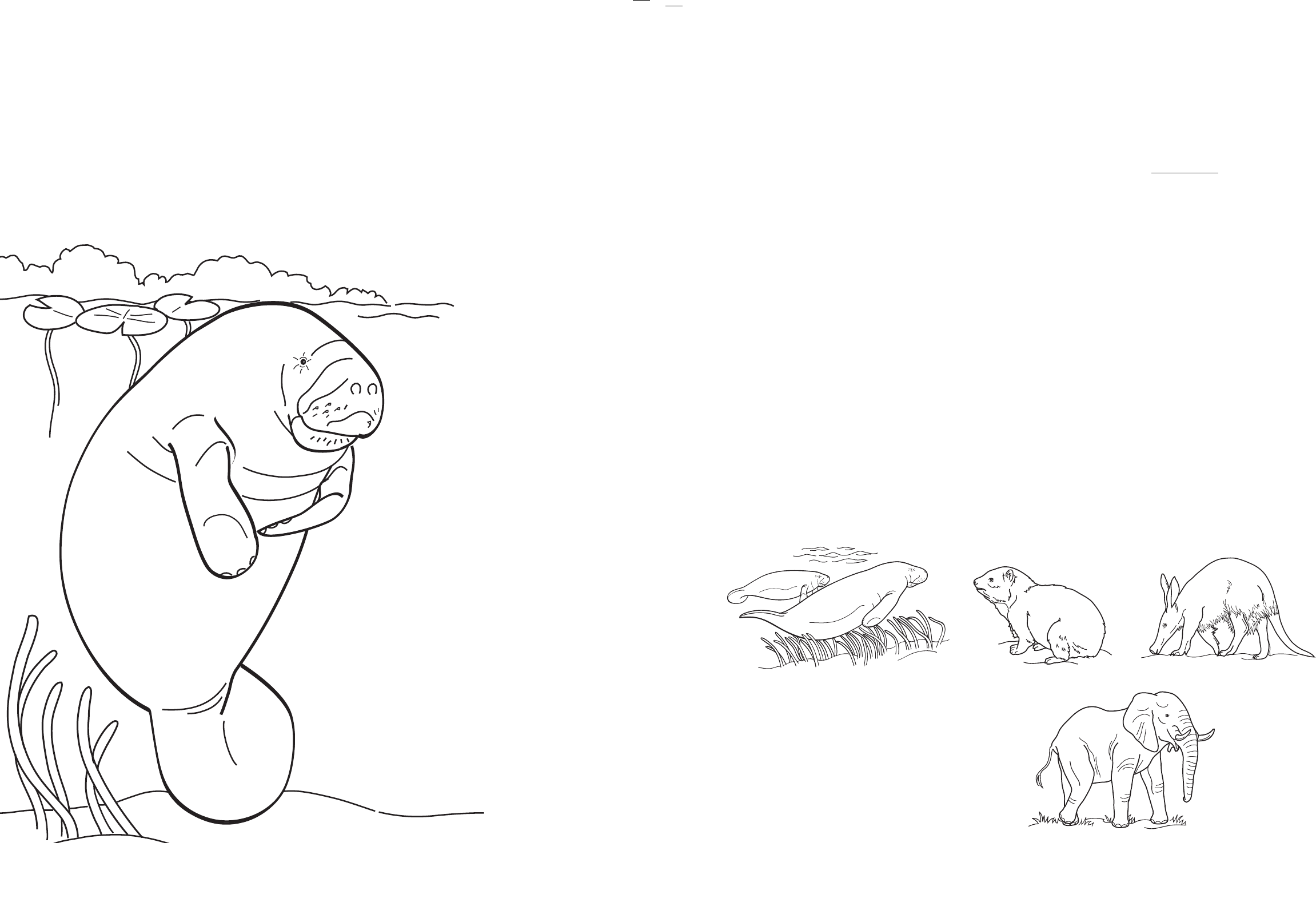
8
Manatee word puzzle
Find these words hidden in the puzzle. Words can be read frontward, backward, up, down and
diagonally.
protect, sea cow, manatee, mammal, aquatic plants, sea grass, habitat, eat, play,
rest, travel, air, water, Florida, conservation
Activity: Put the word list in alphabetic order before doing the puzzle.
ARJ GA T CETORPAB
ASTNALPCI T AUQA
HSE SMMOATT E OR A
AAMANATEERI LED
BMGF GI OAEE ARS I
I PLAYRNTNEEVT R
TAUI EMAMMALSEO
AMTROWUSUNMLML
TMREENAMSNFLI F
AANOI T A VRE SNOC
SRL AL CAWOCAES T
____________________
____________________
____________________
____________________
____________________
____________________
____________________
____________________
____________________
____________________
____________________
____________________
____________________
____________________
____________________
9
Manatee trivia word match
Activity: Fill in the blank with the word that best fits the sentence.
Words: breathe, eyelids, heart, barrier, warm, relatives, submerged, squeaking,
sideways, female, dependent, gestation
■
Manatees do not have _ _ _ _ _ _ _, eyelashes or eyebrows. A clear nictitating membrane
protects the manatees’ eyes when underwater. The muscles around the eye expand and contract
in a circular motion to open and close around the eye.
■
A manatee’s _ _ _ _ _ beats at a rate of 50 to 60 times per minute.
■
Manatees _ _ _ _ _ _ _ air and must surface to breathe approximately every three to five
minutes when active (traveling, socializing or eating).
■
When resting, manatees stay _ _ _ _ _ _ _ _ _ for long periods of time between breaths (20
minutes). A manatee can rest for many hours at a time.
■
A manatee cannot turn its head _ _ _ _ _ _ _ _ – it must turn its whole body around.
■
A manatee communicates by making _ _ _ _ _ _ _ _ _, chirping or whistling sounds.
■
The manatee’s closest modern _ _ _ _ _ _ _ _ _ are elephants, aardvarks and hyraxes.
■
The _ _ _ _ _ _ _ _ _ (pregnancy) period of the manatee is at least 12, and possibly 13,
months long.
■
Calves may remain _ _ _ _ _ _ _ _ _ on their mothers for up to two years.
■
A mating herd consists of one _ _ _ _ _ and several males that travel together for a week to
a month until the female is ready to mate.
■
Manatees learn about _ _ _ _ water sites from their mothers.
Bonus: Study pictures of manatees and on a separate piece of paper draw a manatee’s eye.
How is it different from your eye? (Hint: see the first manatee trivia item above.)
manatees
(Sirenia)
hyrax
(Hyracoidea)
elephant
(Proboscidea)
aardvark
(Tubulidentata)
Closest modern relatives:
Elephant (order Proboscidea) –Very large mammal with
toenails, dense bones, special dentition, long gestation
period, with skin and sparse hair similar to a manatee.
Hyrax (order Hyracoidea) –Size of a rabbit with toenails,
dense bones, special dentition, long gestation period, and a
skull that resembles that of an elephant skull.
Activity: Research the characteristics of the
aardvark and compare the species to manatees,
hyraxes or elephants.
